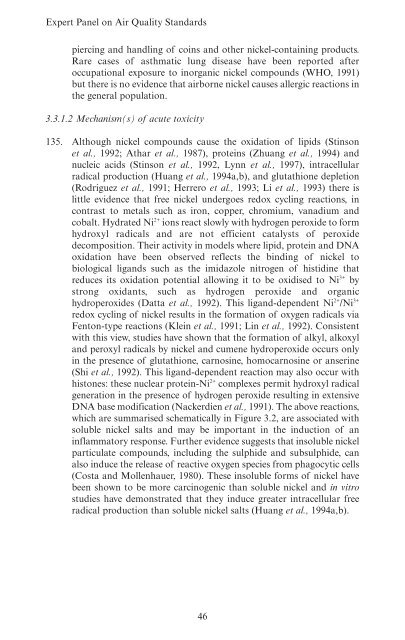Guidelines for Metals and Metalloids in Ambient ... - ARCHIVE: Defra
Guidelines for Metals and Metalloids in Ambient ... - ARCHIVE: Defra
Guidelines for Metals and Metalloids in Ambient ... - ARCHIVE: Defra
You also want an ePaper? Increase the reach of your titles
YUMPU automatically turns print PDFs into web optimized ePapers that Google loves.
Expert Panel on Air Quality St<strong>and</strong>ards<br />
pierc<strong>in</strong>g <strong>and</strong> h<strong>and</strong>l<strong>in</strong>g of co<strong>in</strong>s <strong>and</strong> other nickel-conta<strong>in</strong><strong>in</strong>g products.<br />
Rare cases of asthmatic lung disease have been reported after<br />
occupational exposure to <strong>in</strong>organic nickel compounds (WHO, 1991)<br />
but there is no evidence that airborne nickel causes allergic reactions <strong>in</strong><br />
the general population.<br />
3.3.1.2 Mechanism(s) of acute toxicity<br />
135. Although nickel compounds cause the oxidation of lipids (St<strong>in</strong>son<br />
et al., 1992; Athar et al., 1987), prote<strong>in</strong>s (Zhuang et al., 1994) <strong>and</strong><br />
nucleic acids (St<strong>in</strong>son et al., 1992, Lynn et al., 1997), <strong>in</strong>tracellular<br />
radical production (Huang et al., 1994a,b), <strong>and</strong> glutathione depletion<br />
(Rodriguez et al., 1991; Herrero et al., 1993; Li et al., 1993) there is<br />
little evidence that free nickel undergoes redox cycl<strong>in</strong>g reactions, <strong>in</strong><br />
contrast to metals such as iron, copper, chromium, vanadium <strong>and</strong><br />
cobalt. Hydrated Ni 2+ ions react slowly with hydrogen peroxide to <strong>for</strong>m<br />
hydroxyl radicals <strong>and</strong> are not efficient catalysts of peroxide<br />
decomposition. Their activity <strong>in</strong> models where lipid, prote<strong>in</strong> <strong>and</strong> DNA<br />
oxidation have been observed reflects the b<strong>in</strong>d<strong>in</strong>g of nickel to<br />
biological lig<strong>and</strong>s such as the imidazole nitrogen of histid<strong>in</strong>e that<br />
reduces its oxidation potential allow<strong>in</strong>g it to be oxidised to Ni 3+ by<br />
strong oxidants, such as hydrogen peroxide <strong>and</strong> organic<br />
hydroperoxides (Datta et al., 1992). This lig<strong>and</strong>-dependent Ni 2+ /Ni 3+<br />
redox cycl<strong>in</strong>g of nickel results <strong>in</strong> the <strong>for</strong>mation of oxygen radicals via<br />
Fenton-type reactions (Kle<strong>in</strong> et al., 1991; L<strong>in</strong> et al., 1992). Consistent<br />
with this view, studies have shown that the <strong>for</strong>mation of alkyl, alkoxyl<br />
<strong>and</strong> peroxyl radicals by nickel <strong>and</strong> cumene hydroperoxide occurs only<br />
<strong>in</strong> the presence of glutathione, carnos<strong>in</strong>e, homocarnos<strong>in</strong>e or anser<strong>in</strong>e<br />
(Shi et al., 1992). This lig<strong>and</strong>-dependent reaction may also occur with<br />
histones: these nuclear prote<strong>in</strong>-Ni 2+ complexes permit hydroxyl radical<br />
generation <strong>in</strong> the presence of hydrogen peroxide result<strong>in</strong>g <strong>in</strong> extensive<br />
DNA base modification (Nackerdien et al., 1991). The above reactions,<br />
which are summarised schematically <strong>in</strong> Figure 3.2, are associated with<br />
soluble nickel salts <strong>and</strong> may be important <strong>in</strong> the <strong>in</strong>duction of an<br />
<strong>in</strong>flammatory response. Further evidence suggests that <strong>in</strong>soluble nickel<br />
particulate compounds, <strong>in</strong>clud<strong>in</strong>g the sulphide <strong>and</strong> subsulphide, can<br />
also <strong>in</strong>duce the release of reactive oxygen species from phagocytic cells<br />
(Costa <strong>and</strong> Mollenhauer, 1980). These <strong>in</strong>soluble <strong>for</strong>ms of nickel have<br />
been shown to be more carc<strong>in</strong>ogenic than soluble nickel <strong>and</strong> <strong>in</strong> vitro<br />
studies have demonstrated that they <strong>in</strong>duce greater <strong>in</strong>tracellular free<br />
radical production than soluble nickel salts (Huang et al., 1994a,b).<br />
46
















